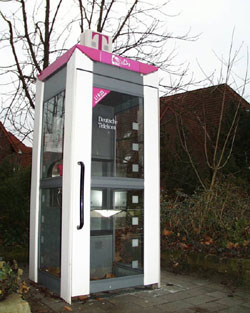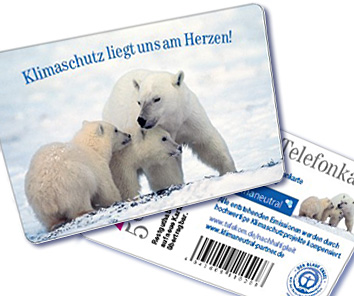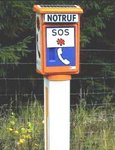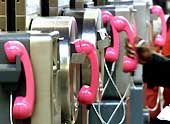8.16 Telephone boxes and telephone numbers
 |
| A Deutsche Telekom phone box |
|
Phoneboxes
Whereas telephone boxes - die Telefonzelle - used to be yellow in colour (see graphic on the previous page), the new Telekom models are grey, white and magenta in colour. These rather unobtrusive colours have given rise to criticism that the new phone boxes are harder to locate in an emergency than the much brighter yellow versions. It's not only the unobtrusiveness of the new phone boxes which has led to a sense that phone boxes have started to disappear from the German landscape. The rise in the usage of mobile phones has led to a reduction in the number of Telefonzellen on German high streets. And owing to an increase in the vandalism of public phone boxes, Deutsche Telekom has introduced open-air "Telestationen". While they don't suffer from broken glass and sundry unhygienic practices, their major drawback is that they don't offer any protection from the wind and rain.
Whilst the older models were coin-operated, approximately half of Germany's 110,000 telephone boxes now require you to use a telephone card (die Telefonkarte). These can be obtained from post offices, kiosks, telephone stores (der Telefonladen) and some stationery outlets. The introduction of the euro has however led to an increase in the usage of coins in phone boxes, and in 2005 Deutsche Telekom started to introduce 10,000 new phones where payment could be made using either coins or phone cards.
From 2003 onwards, Deutsche Telekom has started to replace unprofitable telephone boxes with new telephones that neither accept coins nor phone cards, but instead require Calling Cards as payment. Stripped back to the basics to prevent vandalism, these phones are known as Basistelefone. Compared to traditional phone boxes, which in 2007 cost an average of 7500 euros each, these "basic phones" cost a mere €500. In most public telephone boxes it is possible to be rung back; there should be a sign with the number.

Emergency telephone numbers
The emergency - Notruf - telephone number throughout the European Union (with the exception of Bulgaria) is 112. This is the number that you should call both in Germany and Austria, as well as the non-EU German-speaking countries of Switzerland and Liechtenstein. A EU-wide survey conducted in 2008 concluded however that only 22% of EU citizens could spontaneously identify 112 as the number to call for emergency services anywhere in the EU and called on Member States to boost awareness of 112.
Part of the problem is that each EU country also possesses its own emergency number which its citizens are used to calling in case of emergency. In Germany, the traditional number for calling the police was 110, and this number is still in use alongside 112. There is even a popular East German detective series entitled Polizeiruf 110, which has been broadcast since 1971. In the other German-speaking countries, the following emergency numbers can still be dialled:
- Austria:: 133 to call the police, 122 to call the fire brigade and 144 to call for an ambulance
- Switzerland and Liechtenstein:: 117 to call the police, 118 to call the fire brigade and 144 to call for an ambulance
The information that you should give when reporting an emergency is based around the following questions:
- Where did the incident occur?
- What happened?
- How many people are affected?
- What sort of injury/sickness has taken place?
 Remember too that you should always give a number on which you can be contacted when reporting an emergency, and that you should not end the call until the official on the other end of the phone has no further questions. Emergency calls can be made free of charge from all telephones, including mobile phones. Further opportunities for making emergency calls are provided by emergency telephones - die Notrufsäule - that are located every 500-2,000 metres along German motorways, and also on other major roads and isolated thoroughfares. When using these phones to report an accident, it is crucial to cite the exact position of the emegency phones in kilometres. Other emergency phones are located parks and public buildings, although their frequency is declining as the usage of mobile phones increases. It is in theory also possible for German citizens with hearing or speaking difficulties to send an emergency message with a telecommunications device for the deaf (TDD), but as yet not all emergency networks are equipped with the necessary equipment to receive this. They are encouraged instead to send emergency messages by fax, using the number 112. Remember too that you should always give a number on which you can be contacted when reporting an emergency, and that you should not end the call until the official on the other end of the phone has no further questions. Emergency calls can be made free of charge from all telephones, including mobile phones. Further opportunities for making emergency calls are provided by emergency telephones - die Notrufsäule - that are located every 500-2,000 metres along German motorways, and also on other major roads and isolated thoroughfares. When using these phones to report an accident, it is crucial to cite the exact position of the emegency phones in kilometres. Other emergency phones are located parks and public buildings, although their frequency is declining as the usage of mobile phones increases. It is in theory also possible for German citizens with hearing or speaking difficulties to send an emergency message with a telecommunications device for the deaf (TDD), but as yet not all emergency networks are equipped with the necessary equipment to receive this. They are encouraged instead to send emergency messages by fax, using the number 112.
Directory enquiries
When the Deutsche Bundespost had a monopoly on phone services, you used to ring 118 to find out a German phone number. Since decentralisation however, directory enquiries are provided by a wide range of companies, who charge very different prices for their services. Modern directory enquiries can supply you with more information than just a landline number. Depending on which provider you contact, you can also find out mobile phone numbers, fax numbers, postcodes and even names and addresses of anyone who has placed their details in the telephone directory. All of these companies have telephone numbers that start with 118, and you can find out more about their different services and tariffs by clicking here.
It's cheaper therefore to look up German phone numbers online, and you can do so using the links below:
- Germany:
Das Telefonbuch (the online version of the German telephone directory);
Teleauskunft (a database where you can look up German telephone numbers for companies and private individuals);
Gelbe Seiten (the German equivalent of the Yellow Pages)
- Austria:
Herold (the Austrian telephone directory and Yellow Pages)
- Switzerland and Liechtenstein:
The White Pages (the online version of the Swiss telephone directory);
The Yellow Pages (the Swiss equivalent of the Yellow Pages);
tel.search.ch (a free electronic phone book)
How to give and receive telephone numbers
German telephone numbers are usually said in pairs. This is not true however for the dialling code, so (0475) 24 88 79 would be given as null vier sieben fünf - vierundzwanzig achtundachtzig neunundsiebzig.
If there is an odd number of digits in a German phone number, the first digit is usually isolated and the followed digits are then spoken in pairs, for example 2 34 47 95.
When numbers are said over the telephone or as part of a public announcement, you will also often hear "zwo" instead of "zwei". This is to avoid any confusion as "zwei" could be confused with "drei" if the line is bad. This also applies to compound numbers such as 82 which might be said as "zwoundachtzig" over the phone.

 |
Web Links |
 |
 Chapter 8: Exercises Chapter 8: Exercises
 Nach oben Nach oben
 Print This Page Print This Page
|